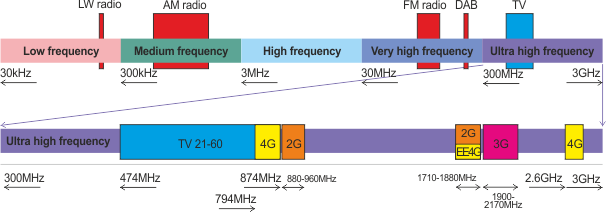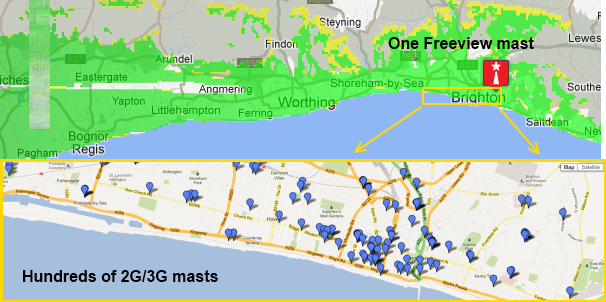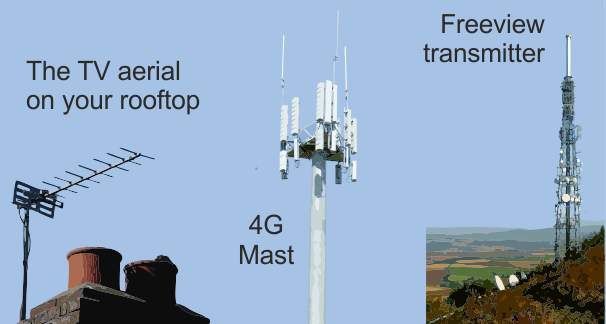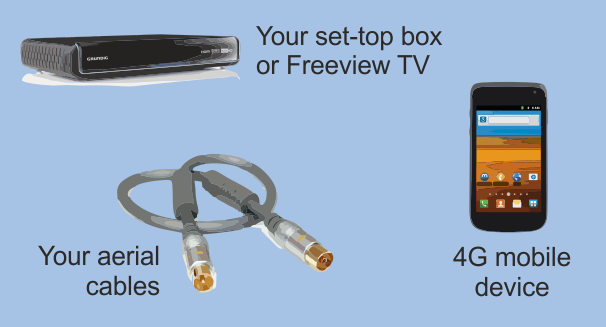How do I know if the 4G broadband will overload my Freeview?
 Brian Butterworth published on UK Free TV
Brian Butterworth published on UK Free TV Back in June 2011, we looked at how Ofcom moves to protect Freeview interference from 4G mobile .
Since then, the television Digital Switchover has been finished and 4th generation (4G) mobile broadband services - also known as Long Term Evoluition (LTE) have launched all over the world, including a service from Everything Everywhere (EE) in the UK.
To understand why and how these 4G broadband services will cause problems during 2013, you need to take into consideration a number of technical factors.
Understanding the radio spectrum
The Radio spectrum is the name given to the frequencies of the electromagnetic spectrum that can be usefully used to transmit radio, television and data services.The top bar on the diagram below (or download) shows a selection of the services used in the UK, with old-fashioned long-wave radio, then medium-wave radio, though FM radio, the digital DAB radio services up to those used for television broadcasting. (See here for a really complex chart).

The highest frequencies on the diagram, the "ultra high frequencies" (or UHF) band is shown enlarged as the lower purple bar. In this range we can see TV "channels C21 to C60" (blue), second- and third- generation mobile phones (2G orange, 3G pink) and the location for the 4G services.
It is important to note that some of the 2G capacity in the "1800MHz" range has already been converted to 4G operation by Everything Everywhere (EE). The other two yellow boxes show the "800MHz" (to the left) "2.6GHz" (on the right).
For the purpose of Freeview reception, only the 800MHz range need be considered. The other two ranges will not cause Freeview problems.
Protecting Freeview receivers against overload
As we have seen already - Freeview signals: too much of a good thing is bad for you - Freeview boxes are designed to protect themselves against signal overloads. When they do this they close down and people often incorrectly diagnose the problem as being "no signal" when there is too much.The problem that has to be solved as the 4G services launch, is that the new mobile broadband signals can cause overloads onto the frequencies that are being used for Freeview.
 One particular problem is that a very common type of Freeview signal decoder, a superheterodyne receivers are sensitive to signals being present nine channels (72MHz) away.
One particular problem is that a very common type of Freeview signal decoder, a superheterodyne receivers are sensitive to signals being present nine channels (72MHz) away.
In addition to overloads, 4G may also cause Signal-Interference Noise Ratio degradation, where reception breaks down because the receiver can no longer decode the digital information in the transmission.
Knowing who will win the 4G auction
 Until the
4G auction takes place, no one will know which company has the right to use the 800MHz channels for mobile devices. The following companies have qualified to bid:
Until the
4G auction takes place, no one will know which company has the right to use the 800MHz channels for mobile devices. The following companies have qualified to bid:
- Everything Everywhere Limited (UK)
- HKT (UK) Company Limited (a subsidiary of PCCW Limited)
- Hutchison 3G UK Limited
- MLL Telecom Ltd
- Niche Spectrum Ventures Limited (a subsidiary of BT Group plc)
- Telefonica UK Limited
- Vodafone Limited
Viewing high power television and using low power mobiles
Using the 'Sitefinder' Mobile Phone Base Station Database you can compare the locations of existing mobile phone "masts" with those used for Freeview Transmitters. Here is an example from Brighton and Hove, where a medium-sized single mast (Whitehawk Hill) can cover a whole city, but where hundreds of mobile phone base-stations cover a many smaller-by-comparison areas.
This illustrates two points. Firstly, that Freeview broadcasts are high powered and one-to-many - mobile devices are low power and peer-to-peer. The mast your TV signal comes from may be miles, sometimes tens or miles away, for your mobile perhaps only meters away.
The second point is that if an existing 2G/3G mobile supplier wins a 800MHz 4G slot, they will wish to use their existing "phone mast" locations (especially the 900MHz ones) as this would be most economical for them. Until the action winners emerge, and then plan their network, only idle speculation about possible interference can be made.
Using the TV frequencies for 4G masts and phones
Research (see here) shows that a 4G mast in relative close proximity, or a mobile 4G handset closer than a meter to an unfiltered Freeview box will cause overloading on many tested devices. The following diagram shows the relationship between the 4G use and the old TV channel designations.
Those Freeview transmitters that use channels above C52 are most likely to have receivers that get overloaded by the use of 4G signals in the 800MHz area. FDD is Frequency-division duplexing - the transmitter and receiver operate at different carrier frequencies.
Interpreting the aerial and mast locations
Once the proposed mast locations for 4G services are known, it will then be possible to predict which homes will need to fit the special filters in areas where Freeview uses the higher channel numbers (the C52 to C60 range).
If you then have a rooftop aerial without a signal amplifier, to get an overload you will need the 4G mast to be in the line-of-sight between your Freeview transmitter and the aerial, or possibly "directly behind" the aerial.
If you then have a rooftop aerial and an amplifier, or perhaps have lower-grade cables, you are likely to need to protect from a 4G overload if the phone mast is close to your rooftop aerial.
Finding transmitters that use the higher range frequencies
Some powerful transmitters and many relays use the high frequencies: Sudbury, Oxford, Belmont, Winter Hill, Tacolneston, Pontop Pike, Mendip, Emley Moor, Clermont Carn, Truskmore and Maghera.Click below to find out the transmitters in with high frequency allocations:
- C60 is used by 126 transmitters - including Sudbury, Oxford, Belmont;
- C59 is used by 142 transmitters - including Winter Hill and Tacolneston;
- C58 is used by 100 transmitters - including Winter Hill, Sudbury, Pontop Pike and Mendip;
- C57 is used by 131 transmitters - including Clermont Carn, Truskmore, Oxford;
- C56 is used by 73 transmitters - including Mendip, Sudbury;
- C55 is used by 139 transmitters - including Maghera, Winter Hill and Tacolneston ;
- C54 is used by 104 transmitters - including Mendip, Pontop Pike and Winter Hill;
- C53 is used by 131 transmitters- including Truskmore, Belmont, Oxford;
- C52 is used by 81 transmitters - including Emley Moor, Sandy Heath, Clermont Carn and Mendip.
Protecting Freeview boxes and sets, cables, amplifiers from 4G devices
Again in areas where Freeview uses the higher channel numbers (C52 and above) you may have to protect your Freeview devices from signals from a 4G handset (such as mobile phone, tablet, or USB "dongle").
This may, once again, require the fitting of a special filter, or the upgrading of the "fly leads" used to connect your aerial to the set top box or TV. This may be a particular problem if you have used an indoor aerial or signal amplifier.
Help with TV/radio stations?
In this section
Monday, 20 May 2013
J
Jo Dee7:00 PM
Jb38 & Dave,
Thank you both for your replies. I'll try the radio tuning method when the signal drops again.
I live in a small mid terrace, so my neighbours are very close!
| link to this comment |
Saturday, 25 May 2013
J
Jo9:17 AM
Hi,
I have had intermittent signal problems for a few months when the weather has been bad, but it was liveable with. At the beginning of the week I had no problems. I went away for a couple of days and came home to find that I had lost all BBC channels. This happened sometime between Tuesday night (because I recorded programmes) and Wednesday night. At this point ITV was fine. On Thursday I also lost ITV, and now I have nothing. I've tried re-tuning but still cannot get anything. My transmitter is Winter Hill.
| link to this comment |
M
Mazbar12:42 PM
Jo: where do you live there are no 4g transmissions in the north west.
| link to this comment |
J
Jo1:30 PM
Mazbar: I live near Oldham. More on the Manchester side, between the M60 and M62. Thanks
| link to this comment |
M
Mazbar3:53 PM
Jo: if it occurs when the weather is bad there are a number of possible reasons , broken or damaged coax, rear reflector lose banging on aerial this would also cause a noise or a tree in line between you and the transmitter, the most likely is the coax faulty unplug the coax from your tv or set top box and look for rust.
| link to this comment |
Sunday, 26 May 2013
J
Jo12:30 PM
Thanks Mazbar. I think I need to get someone to look at my aerial. The weather is great, and I cannot get signal, other than with an indoor aerial.
| link to this comment |
M
Mazbar12:57 PM
Jo: if you need a good aerial man ring grax on 0161 747 2007 they aren't aerial riggers only a aerial supply company but they will steer you in the right direction of a good company being the bank holiday they are open on Tuesday
| link to this comment |
J
Jo1:05 PM
That's great, thank you very much Mazbar. I was wondering how to go about finding a good company..
| link to this comment |
Wednesday, 29 May 2013
N
Nigel Vian9:48 PM
Sandwich
Hi, we live in Sandwich East Kent and pick up Freeview signals from the Dover transmiteer. Up until Sunday everything has been fine for years. The weather was great and no real high pressure issues which sometimes interferes. We did use an SLX2 booster box. But now the signal is very poor, with bit errors and heavy pixilation showing on our Samsung digital TV. My first thought was that the booster box had failed. Replaced it with no difference. My next thought was aerial or coax cabling. Had that all checked by aerial company today - all fine. Aerial is about 20 years old but has been working fine. Checked at800 re any new 4G interference - they came back straight away and said no problems/tests in our area. I checked the Dover transmitter online for faults and as yet nothing showing. I tried a good internal aerial and that gave almost an identical result. So it must be signal. Something is interfering with it. Any suggestions please?
Nigel
| link to this comment |
Nigel's: mapN's Freeview map terrainN's terrain plot wavesN's frequency data N's Freeview Detailed Coverage
Sunday, 2 June 2013
I
Ian from notts8:06 AM
NigelVain-have your tried a factory reset? after that i would try a freeview box on the aerial cable to rule out the tv as the problem
| link to this comment |
Select more comments
Your comment please!